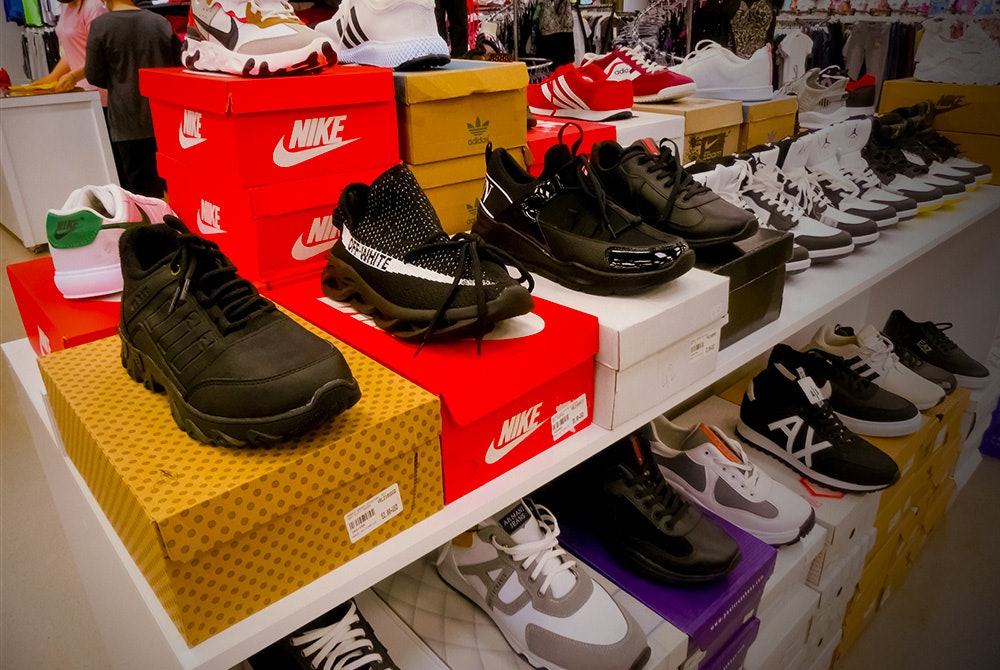- How the Technology Works
- Nike's Other Solutions to Fight Counterfeiters
- Impact of Counterfeit Nikes
- How to Avoid Buying Fake Nike Products
Nike is one of the most commonly counterfeited brands in the world. To tackle the problem, U.S. Customs and Border Protection (CBP) announced in May that they had teamed up with the sportswear brand to prevent counterfeit Nikes from entering the country.
As part of the Donations Acceptance Program, Nike is donating proprietary technology to aid in authenticating Nike products coming into the United States. The technology will be deployed at a limited number of express consignment and international mail facilities.
Deputy Executive Assistant Commissioner of the CBP Office of Field Operations, Diane Sabatino, said, “Our partnerships help strengthen our border security posture through innovation and resource optimization, and continued success in protecting U.S. businesses and consumers from counterfeit goods.”
The Donations Acceptance Program
The Donations Acceptance Program (DAP) is a partnership scheme to implement tangible solutions to border enforcement challenges, including protecting stakeholders and U.S. consumers from counterfeit and potentially unsafe goods.
The DAP enables CBP to accept donations of facilities and technology—like product authentication tools and software—to support U.S. Customs operations and help frontline officers to operate more effectively. Additional benefits of the DAP include:
- Deployment of authentication tools and training in the areas of greatest need.
- Planning and development of new and innovative concepts and ideas.
- Continuous feedback regarding authentication tool usage, accuracy, seizures, and future operational needs.
Other partners of the DAP include Samsonite, Procter and Gamble, OtterBox, Cisco Systems, and the American Red Cross.
In the first five years of the DAP, U.S. Customs entered into 42 partnerships. This has led to more than $218 million in planned and current investment in port of entry improvements, aiding in stemming the flow of counterfeit goods into the U.S.
Fake goods are an ever-increasing problem in the U.S., with counterfeit products worth an estimated $1.3 billion (if they were legitimate) being seized by the CBP in 2020 alone.
This doesn’t account for the shipments that make it into the U.S., with counterfeit goods costing the US economy an estimated $143 billion each year.
How the Technology Works
It’s currently unclear how the CBP will identify fake Nike sneakers, but it may be like the “Legit Check Tech” (LCT) Box from tech startup, Entrupy. Their system uses a combination of software and hardware to identify fake sneakers quickly and accurately.
The LCT Box features eight cameras used to photograph the sneakers to be authenticated from different angles. Artificial intelligence is then used to compare hundreds of data points from the sneaker being analyzed to a database of genuine pairs.
Nike's Other Solutions to Fight Counterfeiters
The partnership with the CBP is not the only way Nike has shown it’s serious about tackling counterfeiters. In January 2021, Nike filed legal action against 676 social media accounts and 589 websites for allegedly selling fake versions of Nike and Converse sneakers.
The lawsuit, filed in New York, seeks an injunction on the sale of the alleged fakes and damages. The defendants are located mainly in Saudi Arabia, China, Bahrain, and other foreign jurisdictions. They are accused of “advertising, offering to sell, and/or selling counterfeit Nike or Converse products to U.S. consumers.”
Furthermore, in 2019, Nike ended its wholesale partnership to sell clothing and shoes through Amazon after finding it too challenging to drive unlicensed resellers and sellers of fakes from the marketplace.
Impact of Counterfeit Nikes
Each time you purchase a counterfeit product—a pair of Nike sneakers or otherwise—a legitimate company loses revenue. Over time, this leads to lost profits and lost jobs.
Besides being illegal, buying counterfeit Nikes also often supports criminal activities, such as human trafficking or forced labor. Buying authentic goods can help prevent the funding of criminal activities and avoid civil or criminal penalties yourself.
- In 2020, the CBP seized over 26,000 shipments containing counterfeit goods, with an estimated value of $1.3 billion.
- In 2020, clothing accounted for 15% of seized counterfeit goods, and shoes for 12%.
- In October 2019, U.S. Customs seized a single shipment containing 14,000+ pairs of fake Nike shoes with an estimated value of over $2 million.
- In 2019, U.S. companies were most affected by counterfeiting, accounting for 24%.
How to Avoid Buying Fake Nike Products
Usually, counterfeit Nike products are of poor quality compared to genuine articles. Plus, you might be putting your online safety at risk as websites selling counterfeit products may compromise your data or contain malware that hijacks your device.
Top tips to avoid unknowingly buying counterfeit Nikes:
- Only buy from reputable websites and resellers.
- Check the web address—scammers often make slight changes to the spelling of the address to fool you into believing it’s a genuine seller.
- When buying from online marketplaces or auction sites, check the seller’s credentials and read reviews.
- Be suspicious of Nike products (especially sneakers) that are significantly cheaper than you can get anywhere else.
- Be wary of Nikes advertised on social media or via text.
- Check the payment page is secure and never pay via bank transfer.


Comments